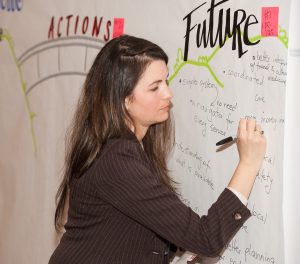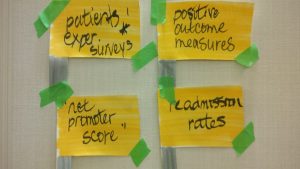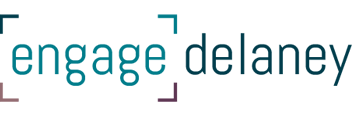Featured Technique: Future-State Action Bridge

The context:
In engagement processes that involve group problem-solving and future planning, it can be easy for participants – and engagement practitioners and facilitators, for that matter – to get bogged down in discussing what’s wrong about the current situation. We can end up spending a lot of time complaining about what’s broken, instead of focusing on what might be possible fixes.
And, if you’re like I used to be, you may believe that it’s important to first identify the issues and problems, before we can, together, move on to exploring possible solutions.
The Future-State Action Bridge technique, however, has demonstrated for me, repeatedly, that it’s actually possible, and very powerful, to start with the future in mind – rather than dwelling on everything that’s not working today. In fact, once this technique gets underway, you will likely find that participants don’t really want to spend much time talking about the current state – even when they’re directly asked about it.
The key to this technique is starting on the right side of the bridge – the future.
The Future-State Action Bridge is an effective, highly interactive technique for identifying an ideal future for whatever problem you’re facing, and then brainstorming the actions or steps that could help achieve that future vision.
Why use this technique?
As we learned recently when using the Future-State Action Bridge for a large-scale engagement with eight different facilitated break-out groups, each discussing different topics, it can be very meaningful and productive to start a future-planning or problem-solving discussion with a forward-looking, positive approach. This method also generates high levels of energy among participants who are free – at least in the moment – from the barriers and constraints of the current situation.
The discussion begins with the question: What does the ideal future look like for this topic/issue/area? Participants are encouraged from the outset to imagine the possible, think big, and focus on an ideal future. As ideas are recorded, the group begins to create a collective vision for that future.

D+A facilitator, Emina, records participant input using the Future-State Action Bridge technique at a recent engagement.
Then, once the ideal future is somewhat fleshed out, participants collectively brainstorm what actions could be taken to get to that future state.
Participants still have an opportunity to discuss the current state – what’s working well and what’s not – but the crucial element of this technique is starting the discussion with the ideal future, then turning to the current situation.
For participants, this is a powerful, participatory and concrete technique to help identify a future vision and possible solutions. For the decision-maker and engagement host, it’s a technique that usually results in high-quality, tangible, participant-driven input, and actionable ideas for implementation.
How does this technique work?
Starting with a specific topic, issue, problem or decision, participants are first asked to describe what an ideal future might look like for that topic. We have found that it’s important not to scope the topic or problem too broadly. For instance, rather than discussing environmental protection in general, we would recommend several separate groups with sub-topics such as waste reduction, energy use, water use, and transportation, to give a few examples, and allow participants to choose the topic they’d most like to discuss.
We also recommend a maximum of 15 participants in each group, and at least one facilitator for each group to facilitate the discussion and record input.
After participants spend a good chunk of time outlining and describing the ideal future, take a shorter amount of time to ask the group about the current state – what’s working well, and what could be improved. You may find that the discussion at this point naturally starts to move into the “action bridge” section of the recording template, and that’s OK.

These pre-cut flags are used to record input about how to measure success, as in, “How will we know we’ve achieved the ideal future?”
Once participants have had an opportunity to share thoughts and ideas about the current state, another longer session is spent on brainstorming and discussing the actions that can help “bridge the gap” between current and future states. A final component to the process is to ask participants how they will know when the ideal state is achieved – the measures, or indicators, of success.
All input from participants is recorded, by the facilitator, in the appropriate section of the pre-drawn, wall-size bridge illustration. The success indicators are recorded on small flags (pre-cut) and added to the future side of the bridge.
This technique can also be augmented to include further group discussion to prioritize the actions identified, or dot voting. If you have many groups discussing the same topic or issue (because of large numbers of participants), other techniques, such as polling, can be added, in order to identify priority actions across the groups.
What is required to pull this off?
As previously noted, we recommend a clear, specific and somewhat narrow topic, issue or problem to be the focus of discussion. At least one facilitator per group of maximum 15 participants is needed. Two facilitators is ideal, if possible – one to record the input, and one to actively facilitate the discussion.
You will also need markers, pre-cut flags, and large recording template posters, like the sketch above, which was created for us by the fantastic graphic recorder Tanya Gadsby of Drawing Out Ideas.
Interested in learning more about this technique, and how it can best be adapted and augmented to fit your engagement? Need some support to implement this for the first time? Give us a call or email us today.



